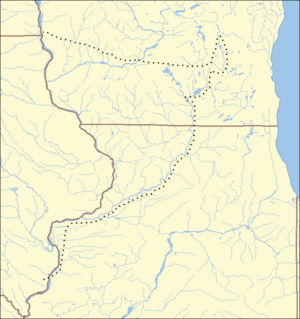Buffalo Grove ambush facts for kids
Quick facts for kids Buffalo Grove ambush |
|||||||
|---|---|---|---|---|---|---|---|
| Part of the Black Hawk War | |||||||
 Historical marker located west of Polo, Illinois |
|||||||
|
|||||||
| Belligerents | |||||||
| Kickapoo warriors | |||||||
| Commanders and leaders | |||||||
| Henry Atkinson James M. Strode |
|||||||
| Strength | |||||||
| 6 | Not known | ||||||
| Casualties and losses | |||||||
| 1 | Not known | ||||||
The Buffalo Grove ambush was a surprise attack during the Black Hawk War on May 19, 1832. A small group of six American soldiers was carrying important messages. They were ambushed by Kickapoo warriors near Polo, Illinois. One soldier, William Durley, was killed during the attack.
What Led to the Ambush?
This ambush was part of the Black Hawk War. This war happened because of disagreements over land. In 1804, a treaty was made about land in Illinois. This treaty caused the Sauk and Fox tribes to move west of the Mississippi River.
However, a Sauk leader named Black Hawk disagreed with the treaty. He said that tribal leaders had not fully agreed to give up their lands. Black Hawk was upset about losing his homeland. From 1830 to 1831, he led his people back into Illinois several times. Each time, he was convinced to return west without fighting.
In April 1832, Black Hawk returned to Illinois with his group. They hoped to find allies among other tribes and the British. But he found no allies. He then tried to go back to Iowa. However, events led to a battle known as the Battle of Stillman's Run. More fights followed, and the state militias of Wisconsin and Illinois were called to find Black Hawk's group. This conflict became known as the Black Hawk War.
Before the Attack
When the Black Hawk War started in spring 1832, settlers at Buffalo Grove were told to leave. This was after Black Hawk's victory at Stillman's Run. Most settlers went to Peoria for safety during the war.
On May 19, 1832, a small group of soldiers was sent on a mission. They had to deliver messages from Colonel James M. Strode in Galena. The messages were for General Henry Atkinson at Dixon's Ferry (now Dixon, Illinois). The group included soldiers Fred Stahl, William Durley, Vincent Smith, Redding Bennett, James Smith, and mail carrier John D. Winters. They left Dixon around 3 p.m. that day.
The Ambush Happens
| Map of Black Hawk War sites Symbols are wikilinked to article |
The Buffalo Grove ambush happened near Buffalo Grove. This is a small area in what is now Ogle County. As the group got close to the edge of the grove, one person thought it was a good spot for an ambush. He suggested they take a different, longer path to avoid danger.
But the idea was not accepted. William Durley rode his horse into the wooded area of the grove. He had only gone a short distance when he was shot. The gunfire came from the very spot that had been suggested as a possible ambush site.
On May 20, 1832, Sergeant Stahl returned to Dixon's Ferry. He was with the four other survivors of the attack. He reported that their group had been ambushed by Native Americans the evening before. Durley was killed instantly and left behind. Stahl and James Smith had bullets go through their clothes, but they were not hurt. William Durley was the only one who died in the attack.
What Happened Next
The events of the Buffalo Grove ambush are connected to the St. Vrain massacre. A group of four men, including Aaron Hawley and John Fowler, were on their way to Galena. They later became victims of the St. Vrain massacre. This group found Durley's body at Buffalo Grove.
The group went back to Dixon's Ferry. They reported what they had found and stayed there overnight. When General Atkinson returned to Dixon on May 23, he had messages for Fort Armstrong. He told Indian Agent Felix St. Vrain to join the group that found Durley's body. They were to travel with them to Galena.
The group left Dixon and traveled north. They found Durley's remains at Buffalo Grove. They buried him there.
The Polo Historical Society put up a memorial for Durley on May 19, 1910. This was 78 years after the attack. At that time, Durley's remains were moved. They were reburied under the new memorial. The Buffalo Grove ambush historical marker and Durley's memorial are located west of Polo, Illinois. They are along Eagle Point Road.


